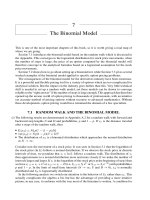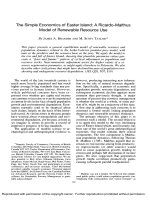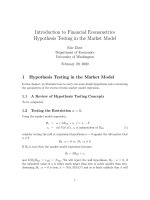the ISLM model
Bạn đang xem bản rút gọn của tài liệu. Xem và tải ngay bản đầy đủ của tài liệu tại đây (511.54 KB, 23 trang )
Copyright 2011
Pearson Canada Inc.
22 -
1
Chapter 22
The ISLM Model
Copyright 2011
Pearson Canada Inc.
22 -
2
Determination of Aggregate Output
The total quantity demanded of an economy’s
output is the sum of four types of spending
Y
AD
= C +I + G + NX
Equilibrium occurs in the economy when the total
quantity of output supplied equals the total
quantity of output demanded.
Y = Y
AD
Analysis assumes that the price level is fixed.
Copyright 2011
Pearson Canada Inc.
22 -
3
Consumption Expenditure and the Consumption Function I
•
Income is the most important factor determining
consumption spending
•
Disposable income (Y
d
) is total income minus taxes (Y-T)
•
The marginal propensity to consume (mpc) is the slope
of the consumption function (ΔC/ΔY
d
)
•
mpc is the change in consumer expenditure that result
from an additional dollar of disposable income
•
a is autonomous consumer expenditure (i.e. expenditure
that is independent of disposable income)
Copyright 2011
Pearson Canada Inc.
22 -
4
Consumption Expenditure and the Consumption
Function II
Copyright 2011
Pearson Canada Inc.
22 -
5
Consumption Function
Copyright 2011
Pearson Canada Inc.
22 -
6
Investment Spending
•
Fixed investment—always planned
•
Inventory investment—can be unplanned
•
Planned investment spending
–
Interest rates
–
Expectations
Copyright 2011
Pearson Canada Inc.
22 -
7
The Keynesian Cross
Copyright 2011
Pearson Canada Inc.
22 -
8
Expenditure Multiplier
•
A change in planned investment spending leads to an
even larger change in aggregate output.
•
An increase in planned investment spending leads to an
additional increase in consumer expenditure which raises
aggregate demand and output further.
−
=
∆
∆
∆
−
=∆
mpcI
Y
I
mpc
Y
1
1
1
1
Copyright 2011
Pearson Canada Inc.
22 -
9
Response of Aggregate Output to a Change in
Planned Investment
Copyright 2011
Pearson Canada Inc.
22 -
10
Response of Aggregate Output to a Collapse in Investment
Spending (1929-1933)
Copyright 2011
Pearson Canada Inc.
22 -
11
Changes in Autonomous Spending
•
Any change in autonomous spending will lead to a
multiplied change in aggregate output
−
+=∆
mpc
IaY
1
1
)(
•
The shift in the aggregate demand function can come
from a change in planned investment, a change in
autonomous consumer spending, or both
•
Changes in autonomous spending are dominated by
“animal spirits”
Copyright 2011
Pearson Canada Inc.
22 -
12
Government’s Role
•
Government spending and taxes can be used to
change the position of the aggregate demand
function
•
Government spending adds directly to aggregate
demand
•
Taxes do not affect aggregate demand directly
•
If taxes change, consumer expenditure changes in
the opposite direction
[ ]
T) X (mpc - Y) x (mpc )( x +=−+= aTYmpcaC
Copyright 2011
Pearson Canada Inc.
22 -
13
Response of Aggregate Output to Government Spending and
Taxes
Copyright 2011
Pearson Canada Inc.
22 -
14
Role of International Trade
A change in net exports (exports – imports) is
positively related to changes in aggregate output
−
∆=∆
mpc
NXY
1
1
Copyright 2011
Pearson Canada Inc.
22 -
15
Response of Aggregate Output to a Change in Net
Exports
Copyright 2011
Pearson Canada Inc.
22 -
16
Response of Aggregate Output to Changes in I, G, T,
NX
Copyright 2011
Pearson Canada Inc.
22 -
17
The ISLM Model
•
Includes money and interest rates in the
Keynesian framework
•
Examines an equilibrium where aggregate output equals
aggregate demand
•
Assumes fixed price level where nominal and real quantities
are the same
•
IS curve is the relationship between equilibrium aggregate
output and the interest rate
•
LM curve is the combinations of interest rates and aggregate
output for which M
D
= M
S
Copyright 2011
Pearson Canada Inc.
22 -
18
Equilibrium in the Goods Market:
The IS Curve
•
Interest rates and planned investment spending
–
Negative relationship
•
Interest rates and net exports
–
Negative relationship
•
The points at which the total quantity of goods
produced equals the total quantity of goods
demanded
•
Output tends to move toward points on the curve
that satisfies the goods market equilibrium
Copyright 2011
Pearson Canada Inc.
22 -
19
Deriving the IS Curve
Copyright 2011
Pearson Canada Inc.
22 -
20
Equilibrium in the Market for Money:
The LM Curve I
•
Demand for money called liquidity preference
•
M
d
/P depends on income (Y) and interest rates (i)
•
Positively related to income
–
Raises the level of transactions
–
Increases wealth
•
Negatively related to interest rates
Copyright 2011
Pearson Canada Inc.
22 -
21
Equilibrium in the Market for Money:
The LM Curve II
•
Connects points that satisfy the equilibrium
condition that M
D
= M
S
•
For each level of aggregate output, the LM
curve tells us what the interest rate must be
for equilibrium to occur
•
The economy tends to move toward points on
the LM curve
Copyright 2011
Pearson Canada Inc.
22 -
22
Deriving the LM Curve
Copyright 2011
Pearson Canada Inc.
22 -
23
The ISLM Diagram: Determination of Output and the
Interest Rate









